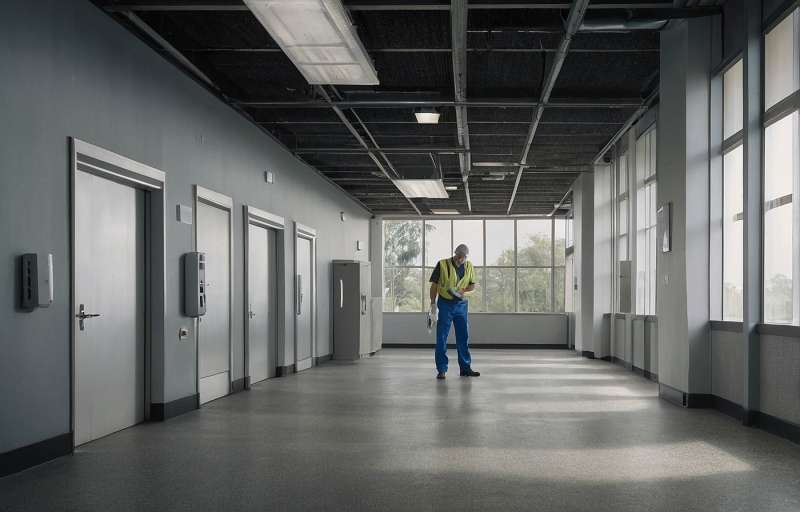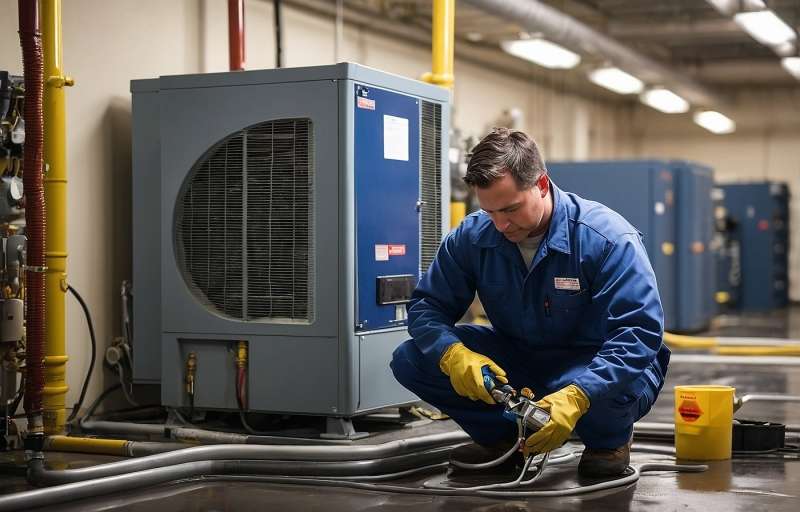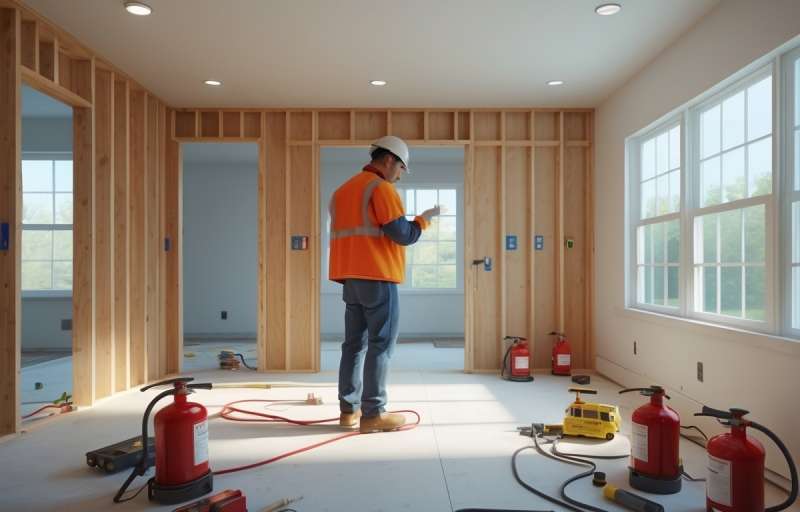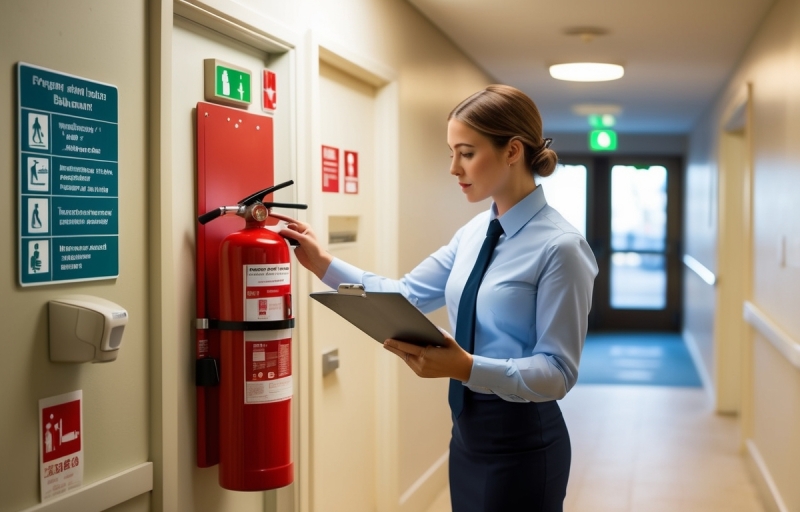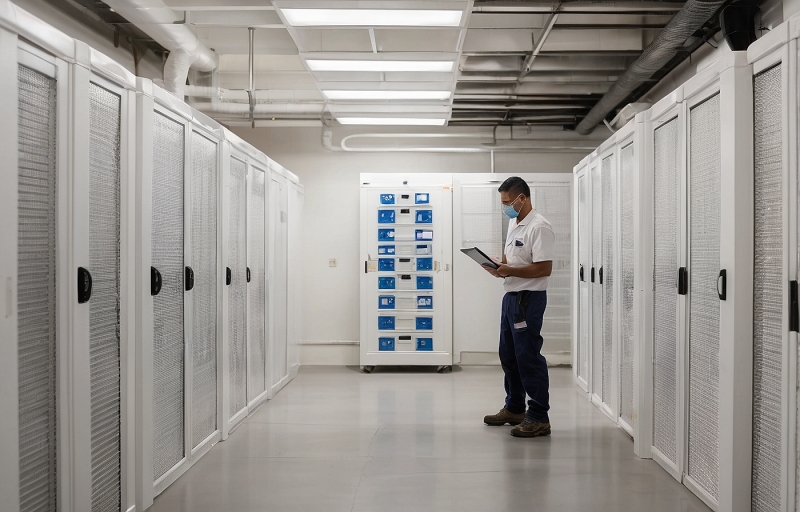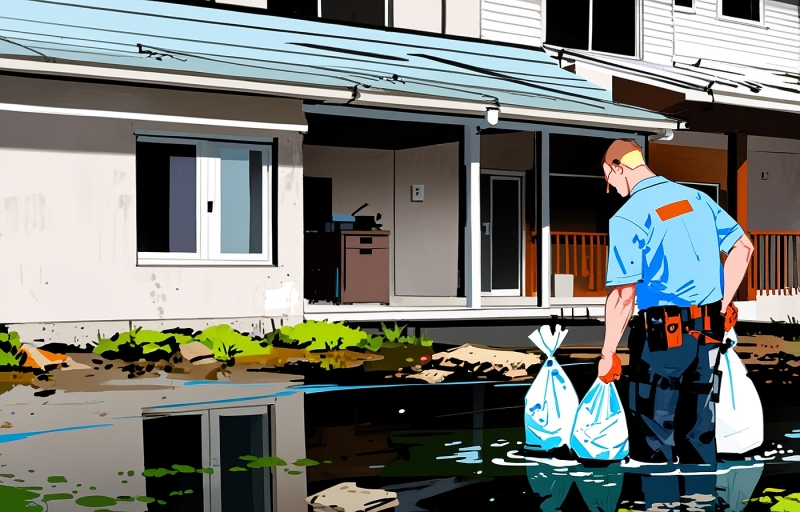Home renovations can breathe new life into your living space, but they also come with unexpected hazards—one of the most serious being fire damage risks during home renovations. Whether you’re upgrading your kitchen, rewiring electrical systems, or using heat-producing tools, the potential for fire hazards increases significantly. At COMMITTED TO QUALITY SERVICE, we understand how critical it is to protect your home during every phase of remodeling. Our team offers fast, friendly, and professional fire damage restoration services to help homeowners recover quickly and safely. With our specialized equipment and expert knowledge, we mitigate affected areas efficiently to prevent further damage. If you’re planning a renovation, it’s essential to be aware of fire safety measures and have a trusted partner ready to respond. Call Us Now! 855-933-7935 for expert assistance and peace of mind.
Common Causes of Fire During Renovation Projects
Home renovation projects are exciting opportunities to enhance the comfort, value, and aesthetics of your living space. However, they also come with a unique set of risks, particularly the increased potential for fire damage. Understanding the common causes of fire during renovation projects is crucial for homeowners, contractors, and renovation teams to ensure safety and prevent costly disasters.
One of the leading causes of fire during home renovations is the use of heat-producing tools and equipment. Devices such as soldering irons, heat guns, welding torches, and grinders are frequently used in tasks like plumbing, roofing, and metalwork. These tools can easily ignite flammable materials such as insulation, wood framing, or dust particles if not handled with care. According to the National Fire Protection Association (NFPA), “hot work” was responsible for an average of 4,580 structure fires per year between 2014 and 2018.
Another significant risk factor is faulty or temporary electrical wiring. During renovations, it’s common to install temporary power sources or rewire parts of the home. If these electrical systems are not properly grounded or are overloaded, they can spark and ignite nearby combustible materials. Older homes are particularly vulnerable, as outdated wiring may not meet current safety standards. It’s essential to have a licensed electrician inspect and manage any electrical modifications to minimize fire hazards.
Improper storage and handling of flammable materials also contribute to fire risks. Paints, solvents, adhesives, and other chemicals used in construction are highly combustible. When stored near heat sources or exposed to open flames, these substances can ignite quickly. Contractors and homeowners should always follow manufacturer guidelines for storage and ensure that these materials are kept in cool, ventilated areas away from ignition sources.
Negligence or lack of awareness is another common cause of fire during renovations. Workers may leave tools running unattended, discard cigarette butts improperly, or fail to clean up flammable debris. These seemingly minor oversights can lead to devastating consequences. Ensuring that all personnel are trained in fire safety protocols and that a fire extinguisher is readily available on-site can significantly reduce these risks.
Additionally, demolition work can expose hidden fire hazards. Tearing down walls or ceilings may reveal old wiring, gas lines, or other combustible elements that were previously concealed. If these components are damaged or disturbed during the renovation process, they can become ignition points. A thorough inspection before beginning any demolition is essential to identify and mitigate these hidden dangers.
“Fire safety should be a top priority during any home renovation project. A single spark can lead to significant property damage, injury, or even loss of life,” warns the U.S. Fire Administration.
To illustrate the most common causes of fire during renovations, consider the following examples:
- A homeowner using a heat gun to remove old paint accidentally ignites nearby insulation, leading to a fire that causes extensive damage to the attic.
- Temporary lighting installed during a kitchen remodel overloads the circuit, sparking a fire that spreads through the walls before firefighters can contain it.
- Improper disposal of oily rags used for staining wood results in spontaneous combustion overnight, destroying a newly renovated basement.
Preventing fire damage during renovations requires a proactive approach. Homeowners should work with licensed professionals who understand the risks and follow strict safety protocols. It’s also wise to consult with a restoration expert to assess potential vulnerabilities before beginning any major project.
For more information on how to protect your home during renovations, visit our services page. If you’re dealing with the aftermath of a fire, our fire damage restoration team is here to help you recover quickly and safely.
To stay informed about other home safety topics, check out our helpful resources such as the blog or learn more about our commitment to safety and excellence on our our mission page.
By understanding and addressing the common causes of fire during renovation projects, you can ensure that your home improvement efforts are both successful and safe.
Electrical Hazards and Wiring Mistakes
During home renovations, one of the most overlooked yet critical fire damage risks stems from electrical hazards and improper wiring practices. Whether you are upgrading your lighting, installing new appliances, or rewiring entire sections of your home, any misstep in electrical work can lead to severe consequences. Faulty wiring is a leading cause of residential fires, and during renovations, the risk increases significantly due to the temporary disruption of existing systems and the introduction of new electrical components. Homeowners often assume that minor electrical tasks can be handled without professional help, but even small errors—such as overloading circuits, using the wrong wire gauge, or failing to secure connections properly—can result in overheating, sparks, or short circuits that ignite surrounding materials.
One common mistake during renovations is failing to adhere to local electrical codes. These codes are in place to ensure safety and efficiency, but DIY renovators or unlicensed contractors may overlook them, either out of ignorance or in an attempt to cut costs. For example, running wires through insulation without proper protection can cause the wires to overheat, increasing the risk of fire. Similarly, connecting new wiring to outdated or damaged electrical panels can create dangerous imbalances in the system. It is essential to have a licensed electrician inspect and approve any electrical work to ensure compliance and safety.
Another significant hazard arises when temporary power sources are used during renovations. Extension cords and temporary wiring setups are often employed to power tools and lighting, but these are not designed for long-term use. Overloading extension cords or daisy-chaining multiple cords together can lead to overheating and electrical fires. Additionally, exposed wires and open junction boxes are common on renovation sites, posing a direct fire risk if they come into contact with flammable materials like wood, drywall dust, or insulation.
Renovation projects also often involve drilling, cutting, or demolishing walls, which can inadvertently damage hidden electrical wiring. Accidentally cutting into a live wire not only poses a risk of electrocution but can also cause sparks that ignite nearby debris. This is particularly dangerous in older homes where wiring may not be up to modern safety standards. Before beginning any demolition or structural changes, it is crucial to map out existing electrical layouts and shut off power to affected areas.
To mitigate these risks, homeowners should prioritize hiring qualified professionals for all electrical work during renovations. A certified electrician will ensure that all installations meet current safety standards and are properly grounded and insulated. Additionally, using high-quality materials and avoiding shortcuts can significantly reduce the likelihood of fire hazards. Regular inspections throughout the renovation process can help identify potential issues early, preventing costly and dangerous outcomes later.
Understanding the broader implications of electrical safety during renovations is vital for protecting your home and family. Fire damage resulting from electrical mistakes can be devastating, leading to loss of property, costly repairs, and even injury. If your home has already suffered from fire-related incidents, seeking professional help is essential. Learn more about our specialized fire damage restoration services to ensure your home is safely restored and protected against future risks.
At Projekt Restoration, we are committed to helping homeowners navigate the complexities of renovation safety. Our team provides a wide range of services designed to identify and address potential hazards before they become serious problems. Whether you are planning a minor remodel or a full-scale renovation, we are here to support you every step of the way. For more information about our approach and values, visit our about page to learn how we prioritize safety, quality, and customer satisfaction in every project.
The Role of Flammable Materials in Fire Risk
During home renovations, one of the most overlooked yet critical fire hazards is the presence and use of flammable materials. These substances, which include solvents, adhesives, paint thinners, insulation, and even sawdust, can significantly increase the risk of fire if not handled properly. Renovation projects often involve a combination of heat-producing tools, open electrical wiring, and combustible materials, creating a perfect storm for potential fire outbreaks. Understanding how these materials contribute to fire risk is essential for homeowners and contractors alike to ensure safety throughout the renovation process.
Flammable materials are commonly used in various stages of home improvement. For instance, oil-based paints and varnishes emit volatile organic compounds (VOCs) that can ignite when exposed to high temperatures or sparks. Similarly, construction dust, especially fine particles like sawdust, can become highly combustible when suspended in the air. When combined with power tools or faulty wiring, these materials can ignite quickly, leading to devastating fire damage. This is why it is crucial to store and dispose of these substances correctly and to maintain proper ventilation in work areas.
Another significant concern is the improper storage of flammable liquids. Many homeowners and even contractors store these materials in garages or basements without considering the potential fire hazards. These areas often lack adequate ventilation and may contain ignition sources such as water heaters or electrical panels. A small spark in such an environment can lead to a major fire. To mitigate this risk, flammable materials should be stored in approved containers and kept away from heat sources. Additionally, it is advisable to limit the quantity of these substances on-site and to use them only when necessary.
Electrical systems also play a role in increasing fire risk during renovations. Temporary lighting, extension cords, and power tools can overload circuits, especially in older homes with outdated wiring. When these electrical components come into contact with flammable materials, the risk of fire escalates. Ensuring that all electrical work is performed by licensed professionals and that circuits are not overloaded is a key step in reducing fire hazards. Moreover, using ground fault circuit interrupters (GFCIs) and circuit breakers can provide an added layer of protection.
It is also important to consider the role of human error in fire incidents. Workers may inadvertently leave heat-producing tools like soldering irons or heat guns unattended, or they may smoke near flammable substances. These actions, though seemingly minor, can have catastrophic consequences. Establishing strict safety protocols and ensuring that all workers are trained in fire prevention can significantly reduce these risks. Homeowners should also be proactive in discussing fire safety measures with their contractors before the renovation begins.
In the unfortunate event that a fire does occur, the damage can be extensive, affecting not only the structure of the home but also personal belongings and indoor air quality. Fire damage restoration is a complex process that requires professional expertise to ensure thorough cleanup and repair. For more information on how to handle such situations, visit our fire damage page. Additionally, our services section provides a comprehensive overview of the restoration solutions we offer to help homeowners recover quickly and safely.
Preventing fire damage during home renovations starts with awareness and proper planning. By understanding the risks associated with flammable materials and taking proactive steps to manage them, homeowners can protect their property and loved ones. Whether you are planning a minor update or a major remodel, always prioritize fire safety to ensure a successful and hazard-free renovation experience.
Importance of Fire Safety Planning Before Renovation
Before beginning any home renovation project, it is crucial to prioritize fire safety planning to prevent potential fire damage risks. Renovations often involve activities that increase the likelihood of fire hazards, such as electrical rewiring, the use of flammable materials, and the operation of power tools. Without a comprehensive fire safety plan in place, homeowners may unknowingly expose their property and loved ones to serious danger. Proper planning not only safeguards the home but also ensures that the renovation process proceeds smoothly and without costly setbacks.
One of the key reasons fire safety planning is essential before renovation is the presence of combustible materials. During remodeling, materials like wood, insulation, and solvents are often stored on-site. When combined with heat sources such as welding equipment or faulty wiring, these materials can easily ignite. A fire safety plan helps identify these risks in advance and outlines strategies to mitigate them, such as proper storage, ventilation, and the use of fire-retardant materials.
Another important aspect of fire safety planning is ensuring that all electrical systems are up to code. Renovations frequently involve modifying or upgrading electrical wiring, which, if done improperly, can lead to short circuits or overheating. Hiring licensed professionals and conducting thorough inspections before and after electrical work can significantly reduce the risk of fire. Additionally, a fire safety plan should include the installation of smoke detectors and fire extinguishers in key areas of the home, especially near construction zones.
Communication with contractors and workers is also vital. Everyone involved in the renovation should be aware of the fire safety protocols in place. This includes knowing the location of fire extinguishers, understanding emergency exit routes, and being trained on how to respond in case of a fire. Clear communication ensures that all parties are aligned in maintaining a safe working environment.
Moreover, fire safety planning should take into account the specific layout and structure of the home. Older homes, for example, may have outdated wiring or hidden structural vulnerabilities that increase fire risk. A thorough assessment of the property before starting renovations can help uncover these issues and allow for proactive measures to be taken. This is especially important for homeowners who have previously experienced water or fire damage, as these incidents can compromise the integrity of building materials.
Incorporating fire safety into the renovation process also aligns with broader home protection strategies. For instance, homeowners who are already addressing issues like water damage or mold remediation can integrate fire prevention measures into their overall restoration plan. This holistic approach not only enhances safety but also adds long-term value to the property.
For those seeking professional guidance, working with experienced restoration and renovation experts can make a significant difference. Companies that specialize in damage restoration often offer comprehensive services that include fire risk assessments and safety planning. These professionals understand the complexities of home construction and can provide tailored solutions that address both immediate and future fire hazards.
Homeowners can also benefit from exploring additional resources and insights provided by reputable restoration companies. Visiting the blog section of a trusted service provider’s website can offer valuable tips on fire prevention, renovation best practices, and emergency preparedness. Staying informed empowers homeowners to make smarter decisions and reinforces the importance of proactive planning.
In conclusion, fire safety planning is a critical step that should never be overlooked before starting a home renovation. By identifying potential hazards, ensuring code compliance, and fostering clear communication among all parties involved, homeowners can significantly reduce the risk of fire damage. Taking these precautions not only protects the home and its occupants but also ensures that the renovation process is both safe and successful.
How to Safely Use Power Tools and Equipment
Using power tools and equipment during home renovations can significantly increase the risk of fire damage if not handled properly. These tools often generate heat, friction, and sparks, all of which can ignite nearby flammable materials. To minimize fire hazards, it is essential to follow strict safety protocols and understand the proper use of each tool. Start by reading the manufacturer’s instructions and safety guidelines for every piece of equipment. Ensure that all tools are in good working condition before use, and never attempt to operate a damaged or malfunctioning device. Regular maintenance and inspections can help prevent electrical faults that may lead to overheating or short circuits.
One of the most important safety measures is to keep your work area clean and free of combustible materials such as sawdust, paper, and solvents. These substances can easily catch fire if exposed to sparks or high heat. Always unplug tools when not in use and avoid overloading electrical circuits, which can cause overheating and potentially start a fire. Using power tools with built-in safety features like automatic shut-off mechanisms and thermal protection can also reduce the risk of fire-related incidents.
Proper ventilation is another critical factor when using power tools, especially those that emit fumes or dust. Poor air circulation can allow flammable vapors to accumulate, increasing the likelihood of ignition. Make sure your workspace is well-ventilated, and consider using fans or exhaust systems to disperse hazardous particles. Additionally, always wear appropriate personal protective equipment such as gloves, goggles, and fire-resistant clothing to protect yourself from sparks and debris.
It is also wise to have a fire extinguisher readily accessible in your work area. Knowing how to use it effectively can make a significant difference in containing a small fire before it spreads. Make sure everyone involved in the renovation project is aware of the location of fire extinguishers and understands basic fire safety procedures. In case of an emergency, having a clear evacuation plan can help ensure everyone’s safety.
When working in older homes, be especially cautious, as outdated wiring and insulation materials can pose additional fire risks. Before beginning any renovation, it may be beneficial to consult with professionals who specialize in fire damage prevention. You can learn more about these services by visiting our services page. If you suspect any hidden issues that could contribute to fire hazards, such as faulty wiring or previous fire damage, it’s crucial to address them before starting your project.
For those unfamiliar with the proper handling of power tools, consider taking a safety course or hiring a licensed contractor. This not only ensures the job is done correctly but also significantly reduces the risk of accidents. At Projekt Restoration, we emphasize the importance of safety and preparedness in every renovation project. To understand more about our commitment to safety and excellence, visit our our mission page.
In conclusion, while power tools are essential for efficient home renovations, they must be used with caution to prevent fire damage. By maintaining equipment, keeping workspaces clean, ensuring proper ventilation, and staying informed about fire safety practices, homeowners can significantly reduce the risk of fire-related incidents. Taking these precautions not only protects your property but also ensures the safety of everyone involved in the renovation process.
Tips for Working with Contractors to Minimize Fire Risk
When undertaking a home renovation, collaborating effectively with contractors is essential to minimizing fire risks. Clear communication and proactive planning can significantly reduce the chances of fire-related incidents during construction or remodeling. Begin by selecting licensed and insured contractors who have experience with fire safety protocols. Before any work begins, discuss fire prevention strategies and ensure that your contractor understands the importance of maintaining a clean and organized worksite. Flammable materials such as paint, solvents, and construction debris should be stored properly and away from heat sources. It is also wise to request a detailed project plan that outlines how fire hazards will be managed throughout the renovation process.
One of the most effective ways to prevent fire damage is by ensuring that all electrical work is performed by a certified electrician. Faulty wiring or overloaded circuits are common causes of fires during renovations. Make sure your contractor obtains the necessary permits and follows local building codes. If your renovation involves welding, soldering, or other heat-producing activities, insist on a fire watch protocol. This includes having a fire extinguisher nearby and monitoring the area for at least 30 minutes after the work is completed to ensure no smoldering materials are left behind.
Daily inspections are another important step in reducing fire risk. Encourage your contractor to conduct end-of-day checks to ensure that all tools are turned off, extension cords are unplugged, and combustible materials are secured. If you are living in the home during renovations, establish clear boundaries between the construction zone and your living space. This not only protects your family but also limits the spread of fire should an incident occur.
It is also beneficial to review your homeowner’s insurance policy before starting any renovation. Some policies may require notification or additional coverage for construction projects. Discuss this with your contractor to ensure that their insurance also covers fire-related incidents. In case of an emergency, having a fire response plan in place can make a significant difference. Make sure all workers know the location of fire extinguishers and exits, and consider installing temporary smoke detectors in the renovation area.
Working with a contractor who values safety and transparency can make your renovation smoother and safer. Ask for references and check reviews to ensure they have a good track record. You can also explore the contractor’s background and values by visiting their about page. A company that prioritizes safety will often have clear guidelines and training in place for their team.
In addition to fire prevention, consider how your renovation might impact other areas of your home. For instance, fire damage can sometimes lead to secondary issues like water damage from firefighting efforts. Understanding the full scope of potential risks can help you plan more effectively. Learn more about comprehensive restoration services that address both fire and water damage to ensure your home is fully protected.
Ultimately, minimizing fire risk during home renovations requires a collaborative effort between you and your contractor. By setting clear expectations, maintaining open communication, and prioritizing safety at every stage, you can significantly reduce the likelihood of fire damage and ensure a successful renovation project.
What to Do If a Fire Breaks Out During Renovation
In the unfortunate event that a fire breaks out during a home renovation, acting quickly and efficiently is crucial to minimize damage and ensure the safety of everyone involved. The first and most important step is to evacuate the premises immediately. Make sure all workers, family members, and pets are safely out of the house. Do not attempt to retrieve personal belongings or tools, as time is of the essence and your safety is the top priority. Once everyone is at a safe distance, call emergency services to report the fire. Provide them with clear information about the location and any potential hazards, such as flammable materials or structural vulnerabilities due to ongoing renovations.
While waiting for emergency responders, avoid re-entering the building under any circumstances. Fires during renovations can spread rapidly, especially when construction materials like wood, insulation, and solvents are present. These materials can accelerate the fire and release toxic fumes, making the environment extremely dangerous. If it is safe to do so and you have access to a fire extinguisher, you may attempt to control a small fire, but only if you are trained and confident in using it. Otherwise, leave firefighting to the professionals.
After the fire has been extinguished and the property is deemed safe to enter, it is essential to assess the extent of the damage. Contact a professional restoration company that specializes in fire damage recovery. They can help evaluate structural integrity, remove debris, and begin the cleanup process. At Projekt Restoration, our expert team offers comprehensive fire damage services to help homeowners recover quickly and safely. We understand the unique challenges that come with fire incidents during renovations and are equipped to handle both minor and extensive damage.
Documenting the damage is another critical step. Take photographs and detailed notes of all affected areas and items. This documentation will be invaluable when filing an insurance claim. Notify your insurance provider as soon as possible and provide them with all necessary information. A reputable restoration company can also assist with the insurance process, ensuring that you receive the compensation you are entitled to.
In addition to fire damage, it is not uncommon for water damage to occur as a result of firefighting efforts. Water used to extinguish the flames can seep into walls, floors, and ceilings, leading to further complications such as mold growth. Prompt action is necessary to address this secondary damage. Our team at Projekt Restoration also offers specialized water damage services to mitigate these risks and restore your home to its pre-loss condition.
Preventing future incidents is equally important. After the fire, take time to review what may have caused the outbreak. Common culprits during renovations include faulty wiring, unattended heat sources, and improper storage of flammable materials. Implementing stricter safety protocols, such as regular inspections and proper storage practices, can significantly reduce the risk of another fire. Educate all workers and household members on fire safety procedures and ensure that fire extinguishers and smoke detectors are readily available and functional.
For more information on how we handle emergencies and support homeowners through the restoration process, visit our services page. You can also learn more about our company values and commitment to safety by exploring our about section. Taking proactive steps and knowing how to respond effectively can make all the difference when facing the unexpected challenge of a fire during home renovations.
In conclusion, while home renovations can breathe new life into your living space, they also come with increased fire risks that should not be overlooked. From electrical upgrades and welding work to the use of flammable materials, each stage of a renovation project presents potential hazards. By staying informed, working with licensed professionals, and implementing proper safety measures, homeowners can significantly reduce the risk of fire damage. Prioritizing fire safety not only protects your investment but also ensures the well-being of everyone in your home. Renovate smart—plan ahead, stay vigilant, and keep fire safety at the forefront of your renovation journey.



